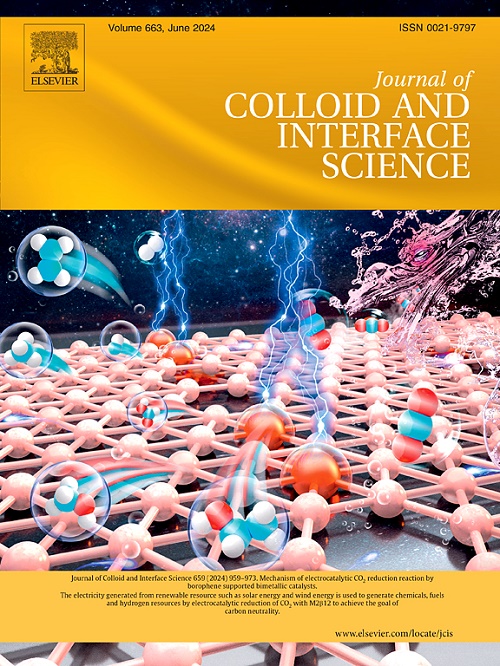Carboxylated cellulose nanocrystals mediated flower-like zinc oxide for antimicrobial without activation of light
IF 9.7
1区 化学
Q1 CHEMISTRY, PHYSICAL
引用次数: 0
Abstract
Conventional light-driven antimicrobial strategies of zinc oxide (ZnO) are limited by inadequate illumination in dark environments. In this study, carboxylated cellulose nanocrystals (MCNC) mediated flower-like ZnO (C0.1@Z) with self-promoted reactive oxygen species release under dark is fabricated. The adsorption of Zn2+ ions on MCNC prompts the growth of ZnO along the (002) crystal plane, forming a flower-like hybrid with superior dispersibility and oxygen vacancies compared to MCNC-free ZnO, which exposes the (100) plane. MCNC serves as an electron donor, increasing oxygen adsorption and electron transfer in C0.1@Z. Consequently, the generation of superoxide anions through oxygen reduction without photoirradiation is significantly boosted, thereby amplifying in-dark antimicrobial activity of C0.1@Z. Incorporating 2.5 % of C0.1@Z into pulp to prepare optimal antimicrobial paper (P-C@Z2.5) results in the prominent bactericidal and fungicidal effects against Staphylococcus aureus (99.8 %), Escherichia coli (99.9 %), Aspergillus niger (12.9 mm inhibition zone), and Botrytis cinerea (11.6 mm inhibition zone) in the absence of light. Additionally, P-C@Z2.5 exhibited low toxicity to cells and significantly extended the shelf life of blueberries to over 21 days. Overall, this work provides a promising approach for designing an effective antimicrobial material in the absence of light to address bacterial colonization of food during dark storage.

无光活化羧化纤维素纳米晶体介导的花状氧化锌抗菌。
传统的光驱动氧化锌(ZnO)抗菌策略受到黑暗环境中光照不足的限制。在本研究中,制备了羧化纤维素纳米晶体(MCNC)介导的具有自促进活性氧释放的花状ZnO (C0.1@Z)。Zn2+离子在MCNC上的吸附促使ZnO沿(002)晶面生长,形成花状杂化物,与MCNC-free ZnO相比,具有更好的分散性和氧空位,暴露(100)平面。MCNC作为电子供体,增加了C0.1@Z中氧的吸附和电子转移。因此,在没有光照射的情况下,通过氧还原产生的超氧阴离子显著增加,从而增强了C0.1@Z在黑暗中的抗菌活性。将2.5%的C0.1@Z加入纸浆中制备最佳抗菌纸(P-C@Z2.5),在没有光线的情况下,对金黄色葡萄球菌(99.8%)、大肠杆菌(99.9%)、黑曲霉(12.9 mm抑制区)和灰霉病菌(11.6 mm抑制区)具有显著的杀菌和杀真菌效果。此外,P-C@Z2.5对细胞具有低毒性,并显着延长蓝莓的保质期至21天以上。总的来说,这项工作为设计一种有效的抗菌材料提供了一种有希望的方法,可以在没有光线的情况下解决食物在黑暗储存期间细菌定植的问题。
本文章由计算机程序翻译,如有差异,请以英文原文为准。
求助全文
约1分钟内获得全文
求助全文
来源期刊
CiteScore
16.10
自引率
7.10%
发文量
2568
审稿时长
2 months
期刊介绍:
The Journal of Colloid and Interface Science publishes original research findings on the fundamental principles of colloid and interface science, as well as innovative applications in various fields. The criteria for publication include impact, quality, novelty, and originality.
Emphasis:
The journal emphasizes fundamental scientific innovation within the following categories:
A.Colloidal Materials and Nanomaterials
B.Soft Colloidal and Self-Assembly Systems
C.Adsorption, Catalysis, and Electrochemistry
D.Interfacial Processes, Capillarity, and Wetting
E.Biomaterials and Nanomedicine
F.Energy Conversion and Storage, and Environmental Technologies

 求助内容:
求助内容: 应助结果提醒方式:
应助结果提醒方式:


